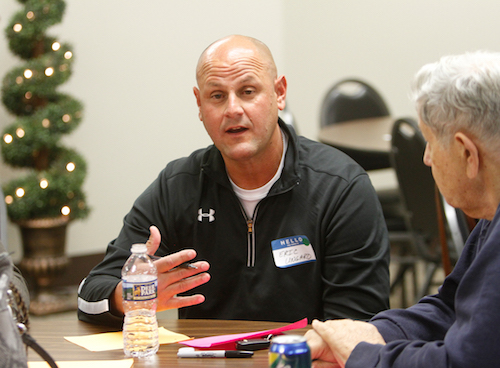Community discusses solutions to opioid epidemic at final Your Voice Ohio event

STRUTHERS
Carolyn Mauro of Canfield, who lost her son to a heroin overdose, felt hopeful after participating Tuesday in a discussion about the opioid epidemic.
“There was a recovering addict here. Mothers like myself who lost a child. News media,” she said. “So many people are coming together to combat this because I think everybody realizes what an epidemic it is.”
“It takes more than one person. It takes a community,” she added.
Your Voice Ohio, a statewide collaborative media project in which The Vindicator, the Warren Tribune Chronicle, 21 WFMJ-TV and WKSU/National Public Radio are participating, brought local community members together this week to brainstorm solutions to the epidemic that kills 4,000 Ohioans per year. The Mahoning Valley effort will be the model for a larger Your Voice Ohio project that will explore solutions across the state.
The final session Tuesday at Mauthe Park in Struthers drew people in recovery, people who had lost loved ones or whose loved ones are struggling with addiction, public health officials, journalists, elected officials, people whose neighborhoods have been affected by the drug scourge and others.
Asked what the opioid epidemic looks like in their community, participants focused on the toll it’s taken on every aspect of society: businesses, local governments, families.
One woman called it the “death of a generation,” and another noted that it has devastated another generation as well – the children growing up with addicted parents or no parents at all.
Some see signs of progress, at least in terms of the community opening up to the topic.
“We’re light years ahead of where we were five years ago,” said Eric Ungaro, who lost his brother to a heroin overdose. “It was horrible five years ago. ... There were no forums like this.”
As for causes of the epidemic, many were quick to note the role that overprescribing of powerful prescription opioids played. In the late 1990s, aggressive marketing of prescription painkillers by pharmaceutical companies led to an overprescribing trend, that, coupled with an influx of heroin, led to today’s epidemic.
Tuesday night’s participants also pondered solutions, and came up with some ideas:
Increase support services for people in recovery.
Do more to end stigma and shame surrounding addiction.
Increase prevention efforts.
Get more success stories out in the news.
Provide additional support to family members affected by addiction.
Take personal responsibility for doing something.
Participants went home with a note to remind themselves of one thing they will do to help solve the problem. Also, local news outlets will remain engaged. Journalists took questions for which participants want answers and will use those questions to plan upcoming stories.
Keep up with the project at YourVoiceOhio.org.
 43
43
